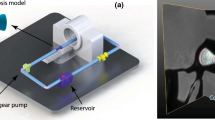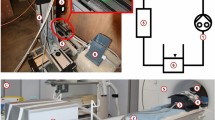Abstract
Noninvasive blood flow measurements by 4D flow-sensitive MRI can be used to compute the intravascular distribution of blood pressure. In this work, we present an efficient algorithm for this task, based on the Navier-Stokes equations including zero-divergence condition for the velocity field. Its accuracy and robustness is investigated on two different CFD-based software phantoms. The method has been integrated into research software for analysis of clinical 4D flow measurements, and is tested on six patients with aortic coarctation. The pressure drop across the stenosis is quantified and coincides well with published results from a previously validated solution algorithm.
Access this chapter
Tax calculation will be finalised at checkout
Purchases are for personal use only
Preview
Unable to display preview. Download preview PDF.
Similar content being viewed by others
References
Markl, M., Harloff, A., Bley, T.A., Zaitsev, M., Jung, B., et al.: Time-resolved 3D MR velocity mapping at 3T: Improved navigator-gated assessment of vascular anatomy and blood flow. J. Magn. Reson. Imaging 25(4), 824–831 (2007)
Markl, M., Kilner, P.J., Ebbers, T.: Comprehensive 4D velocity mapping of the heart and great vessels by cardiovascular magnetic resonance. J. Cardiov. Magn. Reson. 13 (2011)
Tyszka, J., Laidlaw, D., Asa, J., Silverman, J.: Three-dimensional, time-resolved (4D) relative pressure mapping using magnetic resonance imaging. J. Magn. Reson. Imaging 12(2), 321–329 (2000)
Lum, D., Johnson, K., Paul, R., Turk, A., Consigny, D., Grinde, J., Mistretta, C., Grist, T.: Transstenotic pressure gradients: measurement in swine–retrospectively ECG-gated 3D phase-contrast MR angiography versus endovascular pressure-sensing guidewires. Radiology 245(3), 751–760 (2007)
Bock, J., Frydrychowicz, A., Lorenz, R., Hirtler, D., Barker, A.J., Johnson, K., Arnold, R., Burkhardt, H., Hennig, J., Markl, M.: In Vivo Noninvasive 4D Pressure Difference Mapping in the Human Aorta: Phantom Comparison and Application in Healthy Volunteers and Patients. Magn. Reson. Med. 66(4), 1079–1088 (2011)
Meier, S., Hennemuth, A., Friman, O., Markl, M., Preusser, T.: Noninvasive 4D Blood Flow and Pressure Quantification in Central Blood Vessels via PCMRI. Online Archives of Computing in Cardiology 37, 903–906 (2010)
Ebbers, T., Farneback, G.: Improving computation of cardiovascular relative pressure fields from velocity MRI. J. Magn. Reson. Imaging 30(1), 54–61 (2009)
Gresho, P.M., Sani, R.L.: Incompressible Flow and the Finite Element Method. Isothermal Laminar Flow, vol. 2. John Wiley & Sons (2000)
Bolin, C., Raguin, L.: Methodology to estimate the relative pressure field from noisy experimental velocity data. J. Phys.: Conf. Series 135, 012020 (2008)
Song, S., Napel, S., Glover, G., Pelc, N.: Noise reduction in Three-dimensional Phase-Contrast MR Velocity Measurements. J. Magn. Reson. Imaging 3, 587–596 (1993)
Weston, S., Wood, N., Tabor, G., Gosman, A., Firmin, D.: Combined MRI and CFD Analysis of Fully Developed Steady and Pulsatile Laminar Flow through a Bend. J. Magn. Reson. Imaging 8, 1158–1171 (1998)
Hennemuth, A., Friman, O., Schumann, C., Bock, J., Drexl, J., et al.: Fast interactive exploration of 4D MRI flow data. In: Wong, K.H., Holmes, D.R. (eds.) Medical Imaging 2011: Visualization, Image-Guided Procedures and Modeling, vol. 7964, p. 79640E. SPIE (2011)
Author information
Authors and Affiliations
Editor information
Editors and Affiliations
Rights and permissions
Copyright information
© 2013 Springer-Verlag Berlin Heidelberg
About this paper
Cite this paper
Meier, S., Hennemuth, A., Drexl, J., Bock, J., Jung, B., Preusser, T. (2013). A Fast and Noise-Robust Method for Computation of Intravascular Pressure Difference Maps from 4D PC-MRI Data. In: Camara, O., Mansi, T., Pop, M., Rhode, K., Sermesant, M., Young, A. (eds) Statistical Atlases and Computational Models of the Heart. Imaging and Modelling Challenges. STACOM 2012. Lecture Notes in Computer Science, vol 7746. Springer, Berlin, Heidelberg. https://doi.org/10.1007/978-3-642-36961-2_25
Download citation
DOI: https://doi.org/10.1007/978-3-642-36961-2_25
Publisher Name: Springer, Berlin, Heidelberg
Print ISBN: 978-3-642-36960-5
Online ISBN: 978-3-642-36961-2
eBook Packages: Computer ScienceComputer Science (R0)




